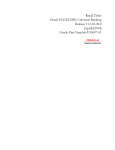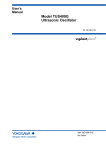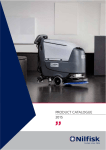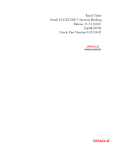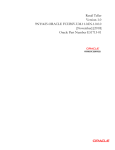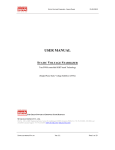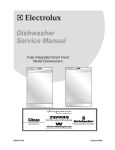Download Product Manual - MAI Animal Health
Transcript
Value Diagnostics DVM Rapid Test™ II Multi-Test Analyzer & DVM Rapid Test™ II Sperm Concentration Analyzer Operation Manual 13-70-040 A Declaration of CE-Conformity Déclaration de conformité CE / CE -Declaración de conformidad ——————————————————————————————————————— Manufacturer / Fabricant / Fabricante: Orbeco-Hellige, Inc. / 6456 Parkland Drive / Sarasota, FL 34243-4036 / U.S.A. ——————————————————————————————————————— Product name / Nom du fabricant / Nombre del productor: SC450, Single Prarameter Colorimeter ——————————————————————————————————————— Declaration of EC-Conformity according to DIRECTIVE 2004/108/EG OF THE EUROPEAN PARLIAMENT AND OF THE COUNCIL of 2004, December the 15th. The manufacturer declares that this product meets the requirements of the following product family standard: Déclaration de conformité CE conformément à la DIRECTIVE 2004/108/CE DU PARLEMENT EUROPÉEN ET DU CONSEIL du 15 décembre 2004. La fabricant déclare que le produit est conforme aux exigences de la norme de famille de produits suivante : CE - Declaración de conformidad conforme a la NORMA 2004/108/ CE DEL PARLAMENTO Y DEL CONSEJO EUROPEO del 15 de diciembre de 2004. El fabricante declara, que este producto cumple con las exigencias de la siguiente norma correspondiente a la familia de productos: ——————————————————————————————————————— DIN EN 61326-1:2006 ——————————————————————————————————————— Basic immunity test requirements (Table1) / Emission according to the requirements for class B equipment Conformément aux exigences fondamentales relatives aux essais d'immunité (tableau 1) / Émissions parasites conformément aux exigences applicables aux appareils de la classe B De acuerdo a los requisitos básicos de verificación para la resistencia a interferencias (tabla 1) / Emisión de interferencias conforme a las exigencias para aparatos de clase B Sarasota, FL. 01. November 2010 Bradley K. Martell, President Table of Contents Technical Specifications General Notes Test Code Menu Operation Instructions Menu Options Menu Options - Recall of Stored Data Menu Options - Printing Data Menu Options - Setting Date and Time Pictorial Test Procedure Instructions Calibration Check Instrument Calibration Check Log 1 2-5 6 7 8 9 10 11 12 - 20 21 - 22 23 Technical Specifications Instrument Single wavelength, direct reading colorimeter Light source LED, interference filter (IF) and photosensor in transparent cell chamber. Wavelength specifications of the IF: 530 nm, Δ λ = 5 nm Wavelength accuracy ± 1 nm Photometric accuracy* 3% FS (T=20 - 25°C) Photometric resolution 0.01 A Power supply 4 batteries (AAA) Lifetime: Approximately 17 hours or 5000 tests Auto-Off Instrument automatically turns off 15 minutes after last key is pressed Display Backlit LCD: Turn on, press [!] key Storage Internal memory for 16 data sets Interface IR interface for data transfer Time Real time clock and date Calibration Factory calibration Dimensions 155 x 75 x 35 mm (L x W x H) Weight Approximately 260 g (including batteries) Ambient conditions Temperature: 5 - 40°C (40 - 104°F) Waterproof Floating; IP 68 (1 hour at 0.1 meter) CE Certificate for Declaration of CE-Conformity at www.orbeco.com *measured with standard solutions 1 General Notes Guidelines for Photometric Measurements 1. The outside of the vial must be clean and dry before starting the analysis. Clean the outside of the vial with a lint-free cloth to remove fingerprints or other marks. 2. Always perform zeroing and testing functions with the vial cap tightly closed. 3. Bubbles on the inside wall of the vial lead to incorrect measure- ments. To prevent this, remove the bubbles by gently inverting the vial several times before performing the test. 4. Avoid spillage of solutions into the sample chamber. This can lead to incorrect test results. 5. Contamination of the cell chamber can result in incorrect read- ings. Always store the unit in locked original case. Clean inside of case and unit as necessary to minimize dust. 6. Large temperature differences between the instrument and the environment can lead to errors (e.g. due to the formation of condensation in the cell chamber or on the vial). Always allow the instrument and reagents to equilibrate to ambient conditions (room temperature) for 30 minutes prior to performing tests. 7. To avoid errors caused by stray light, do not use the instrument in bright sunlight. 2 General Notes Test Kits Available for the DVM Rapid Test™ II There are 6 test kits available for the DVM Rapid Test™ II. The test kits are supplied with blank solutions, reagent solutions, diluent solution (when required), control standards, and complete instructions for preparing samples and running the test. Item Description 49500-1 Serum/Plasma IgG Test Kit - Equine, DVM Rapid Test™ II 49505-1 Colostrum IgG Test Kit - Equine, DVM Rapid Test™ II 49550-1 Serum/Plasma IgG Test Kit - Bovine, DVM Rapid Test™ II 49555-1 Colostrum IgG Test Kit - Bovine, DVM Rapid Test™ II 49530-1 Serum/Plasma IgG Test Kit - Camelid, DVM Rapid Test™ II 49510-1 Sperm Concentration Test - All Species, DVM Rapid Test™ II UOM 12/Box 12/Box 12/Box 12/Box 12/Box 25/Box DVM Rapid Test™ II - Multi-Test Analyzer Tests: • Serum/Plasma IgG - Equine, Bovine, and Camelid • Colostrum IgG - Equine and Bovine • Sperm Concentration - Equine DVM Rapid Test™ II - Sperm Concentration Analyzer Tests: • Sperm Concentration - Bovine, Equine, Canine, and Porcine 3 General Notes Theory of Operation The DVM Rapid Test™ II has been factory calibrated to perform a variety of tests (see Test Code Menu on page 6). The instrument operates by sending a beam of light through the sample to a detector. The percentage of light absorbed by the sample (absorbance) is used to calculate the concentration of the analyte of interest. The test kits used to prepare samples are designed specifically for use with the DVM Rapid Test™ II. The test kits have special chemistry that results in prepared samples with turbidity (cloudiness). The more analyte of interest present in the sample, the more turbid the prepared sample will become. Samples with more turbidity result in higher absorbance values. Samples with lower tubidity result in lower absorbance values. Using the absorbance values and pre-set factory calibration, the DVM Rapid Test™ II accurately calculates the amount of analyte of interest in the sample. When using the test kits in combination with DVM Rapid Test™ II, there is no additional calculation required. Simply prepare the sample according to the test kit instructions and analyze the sample following the Quick Instruction Guide (inside the DVM Rapid Test™ II case). The instrument will perform all the required calculations and display a value for the analyte of interest. Then simply record the value, look it up later with the Recall Saved Data function, or print the results with the Infrared Interface Module (IRiM) (see page 10). 4 General Notes (B) Battery Compartment Cover Replacement of Batteries: (E) Seal Ring AA LR A/ LR 03 03 (F) Instrument Back 03 A/ AA LR A/ AA LR A/ 03 AA (A) Screws (C) Notch (D) Batteries CAUTION: To ensure that the instrument is waterproof: • Seal Ring (E) must be in position • Battery Compartment Cover (B) must be affixed with the four screws If the batteries are removed for more than one minute, the date and time menu starts automatically the next time the unit is turned on. 5 Test Code Menu DVM Rapid Test™ II - Multi-Test Analyzer Display (Code) Test Description Units BSIG Bovine Serum/Plasma IgG mg/dl BCIG Bovine Colostrum IgG mg/dl CSIG Camelid Serum/Plasma IgG mg/dl ESIG Equine Serum/Plasma IgG mg/dl ECIG Equine Colostrum IgG mg/dl ESC Equine Sperm Concentration 106/ml (millions/ml) DVM Rapid Test™ II - Sperm Concentration Analyzer Display (Code) Test Description Units Bsc Bovine Sperm Concentration 106/ml (millions/ml) csc Canine Sperm Concentration 106/ml (millions/ml) ESC Equine Sperm Concentration 106/ml (millions/ml) PSC Porcine Sperm Concentration 106/ml (millions/ml) 6 Operation Instructions DVM Rapid Test™ II - Multi-Test Analyzer & Sperm Concentration Analyzer Turn on unit by pressing the [On/Off] key. On/Off BSIG Mode CSIG The display shows the code for last test selected. Select the required test by pressing the [Mode] key. (Each time the [Mode] key is pressed it will toggle to the next test). When desired test is displayed proceed to the next step. (See test menu). The display shows the code for selected test. Zero/ Test Insert the Clean Sample Blank (for IgG Test) or Reagent Blank (for Sperm Concentration Test) into tube slot on the DVM Rapid Test™ II then press the [Zero/Test] key. 0.0.0 Test Code flashes for 8 seconds and then display shows 0.0.0. Zero/ Test Remove the blank. Then remix and insert the test sample tube into tube slot. Press the [Zero/Test] key. 756 Test Code flashes for 8 seconds and then display shows results for test sample. Repeating the test: With the sample tube in sample chamber, press the [Zero/Test] key again. Repeating the zero: Press the [Zero/Test] key for 2-3 seconds. Display the backlight: Press the [!] key to turn the display backlight on or off. The backlight is automatically turned off during measurements. 7 Menu Options The menu function will allow you to recall stored data, print previous test data, set the date and time, and reset the factory calibration. To complete any of these functions, follow the steps below. With the instrument turned off, press and hold the [Mode] key. Mode While holding the [Mode] key, turn the unit on using the [On/Off] key. Allow the 3 decimal points to be displayed before releasing the [Mode] key. On/Off ! Press the [!] key to scroll through the options. When the desired option is displayed, press the [Mode] key. Follow the steps below to complete each option. ... Store Date di S - Recall Stored Data di S Time Cal Store Date Prt - Printing Stored Data Prt Time Cal Store Date - Setting the Date and Time Time Cal Store Date - User Calibration Mode Time Cal The selected menu is indicated by an arrow in the display. 8 Menu Options - Recall of Stored Data Store Date di S - Recall Stored Data di S Time Cal Mode Mode After confirming the Recall Stored Data section with the [Mode] key, the display will show the most recent test performed. The previous 16 tests are stored in the instrument, with test 1 being the oldest and test 16 being the most recent. 1. Number: n xx (e.g. n 01....16) 2. Year: YYYY (e.g. 2012) 3. Date: mm:dd (e.g. 10:24) 4. Time: hh:mm (e.g. 10:26) 5. Test: Code (e.g. ESIG) 6. Result: XXXX (e.g. 1027) Scroll through the stored tests by pressing the [Mode] key. Once the desired test is displayed, pause and allow the instrument to automatically display the 6 test parameters. The display will automatically scroll to the next parameter every 3 seconds. Press the [Zero/Test] key to repeat the current data set. Press the [Mode] key at any time to scroll to the next data set. Zero/Test Press the [!] key to exit the menu. ! 9 NOTE: Each time a new test is performed, the oldest test result is removed and the new test result is saved. Menu Options - Printing Data Store Date Prt - Printing Stored Data Prt Time Cal Mode Note: To print data, or to transmit to a PC, the optional IRiM (Infrared Interface Module) is required. After confirming the Print Data selection with the [Mode] key and ensuring the IRiM and computer/printer are ready, press the [Mode] key to start transmitting the data. The instrument will display PrtG (Printing) followed by the number of the first data set and its transmission. All data sets will be automatically transfered one at a time. The instrument will automatically return to test mode when data transmission is complete. PrtG On/Off E 132 The print job can be cancelled by pressing the [On/Off] key to turn the instrument off. If the instrument is not able to communicate with the IRiM, a timeout occurs after approximately 2 minutes. The error code E 132 is displayed for approximately 4 seconds. Then the instrument returns to test mode (refer to the IRiM manual). 10 Menu Options - Setting Date and Time Store Date - Setting the Date and Time Time Cal Note: When setting the date and time, the [Mode] key will increase the value and the [Zero/Test] key will decrease the value. The [!] key will proceed to the next value. The date and time settings can be changed in the Setting Date and Time menu function. After confirming the Setting Date and Time selection with the [Mode] key, the display will flash SET, DATE, YYYY. Set the year by using the [Mode] and [Zero/Test] keys. After setting the year, proceed to setting the month by pressing the [!] key. The display will flash R7R7. Use the [Mode] and [Zero/Test] keys to set the month. After setting the month, proceed to setting the day by pressing the [!] key. The display will flash dd. Use the [Mode] and [Zero/Test] keys to set the day. After setting the day, proceed to setting the hour by pressing the [!] key. The display will flash hh. Use the [Mode] and [Zero/Test] keys to set the hour. NOTE: The instrument uses a 24-hour clock. After setting the hour, proceed to setting the minutes by pressing the [!] key. The display will flash R7R7. Use the [Mode] and [Zero/Test] keys to set the minutes. The digit that is flashing is the digit that will be altered by pressing the [Mode] and [Zero/Test] keys. After the correct setting is reached, press the [!] key to proceed to the next digit. After the next digit is set, press the [!] key again to exit the Setting Date and Time function. IS SET will flash on the display and the instrument will return to test mode. Error codes E27/E28/E29 Light absorption too great. Reasons; e.g. dirty optics. E10 / E11 Calibration factor “out of range”. E 20 / E21 Too much light is reaching the detector. E23/E24/E25 Too much light is reaching the detector. E 22 11 Battery capacity was too low during measurement. Change battery. Pictorial Test Procedure Instructions Serum/Plasma IgG »» What You Need To Run Test: • Serum/Plasma IgG Kit • 10 µl micropipette and yellow micropipette tips • Timer • DVM Rapid Test™ II Multi-Test Analyzer • Patient sample(s) • Operation Manual and product inserts »» Step One: Set Up Test Tubes • 30 minutes prior to testing, equili- brate to room temperature one Sample Blank Tube (Pink Cap) and one Reagent Tube (White Cap) for each patient sample or Control to be tested. • Label both the Sample Blank and corresponding Reagent Tube, then remove and save the caps. »» Step Two: Acquire Sample for Serum/Plasma IgG • Using the white 10 µl micropipette, place a yellow pipette tip on the micropipette. • Push plunger down until it stops. Place tip just below the surface of the serum or plasma sample and release plunger slowly. • Remove tip from sample. Wipe any excess liquid from the outside of the pipette tip. Avoid touching end of tip. Ensure there are no air bubbles visible. If air bubbles are present, dispense sample back into the original container and resample using a new micropipette tip. 12 Pictorial Test Procedure Instructions »» Step Three: Add Test Sample(s) to Sample Blank and Reagent Tube(s) • Place tip just under the surface of the liquid in the Sample Blank Tube and push plunger down, then release plunger. Repeat twice. With the plunger down, withdraw the pipette, remove and discard the tip. Replace Pink Cap on tube. • Repeat this procedure with the Sample Reagent Tube (White Cap) using a new pipette tip. »» Step Four: Mix Sample(s) • Gently invert Sample Blank and Reagent Tubes five times. »» Step Five: Set Time For Incubation of Sample(s) • Set timer for 10 minutes. • Start timer to begin room temperature incubation. »» See page 17 for performing IgG test measurement 13 Pictorial Test Procedure Instructions Colostrum IgG »» What You Need To Run Test: • Colostrum IgG Kit • 10 µl and 1000 µl micropipettes • 200 µl (yellow) and 1250 µl (clear) micropipette tips • Timer • DVM Rapid Test™ II Multi-Test Analyzer • Colostrum sample(s) • Operation Manual and product inserts »» Step One: Set Up Test Tubes • Remove one Dilution Tube (Green Cap), one Sample Blank Tube (Red Cap) and one Reagent Tube (White Cap) for each colostrum sample to be tested. • Label each set of matched tubes, place in rack with sample and then remove and save the Green Caps from the Dilution Tubes. »» Step Two: Prepare Sample(s) • Using the 1000 µl micropipette, place a clear 1250 µl pipette tip onto the micropipette. • Push plunger down until it stops. Place tip just below the surface of the colostrum sample and release plunger slowly. • Remove tip from sample. Wipe any excess liquid from the outside of the pipette tip. Avoid touching end of the tip. Ensure there are no air bubbles visible. If air bubbles are present, dispense sample back into the original container and resample using a new micro- pipette tip. 14 Pictorial Test Procedure Instructions »» Step Three: Dilute and Mix Colostrum Sample(s) • Place tip just under the surface of the diluent in the Dilution Tube and push plunger down, then release plunger. Repeat twice. With the plunger down, withdraw the pipette, remove and discard the tip. • Recap with the original Green Cap and mix the Dilution Tube(s) by inversion five times. »» Step Four: Acquire Sample for Colostrum IgG • Using the white 10 µl micropipette, place a yellow pipette tip on the micropipette. • Push plunger down until it stops. Place tip just below the surface of the colostrum sample and release plunger slowly. • Remove tip from sample. Wipe any excess liquid from the outside of the pipette tip. Avoid touching end of tip. Ensure there are no air bubbles visible. If air bubbles are present, dispense sample back into the original container and resample using a new micropipette tip. 15 Pictorial Test Procedure Instructions »» Step Five: Add Test Sample(s) to Sample Blank and Reagent Tube(s) • Place tip just under the surface of the liquid in the Sample Blank Tube and push plunger down, then release plunger. Repeat twice. With the plunger down, withdraw the pipette, remove and discard the tip. Replace Pink Cap on tube. • Repeat this procedure with the Sample Reagent Tube (White Cap) using a new pipette tip. »» Step Six: Mix Sample(s) • Gently invert Sample Blank and Reagent Tubes five times. »» Step Seven: Set Time for Incubation of Sample(s) • Set timer for 10 minutes. • Start timer to begin room temperature incubation. »» See page 17 for performing IgG test measurement 16 Pictorial Test Procedure Instructions »» Step Six: Performing Test Measurement(s) • When the 10 minute incubation is complete: A. Turn on DVM Rapid Test™ II by pressing the [On/Off] key once. Display will show the last test performed. Select test by pressing the [Mode] key until display shows correct test. B. Wipe off Sample Blank Tube (Pink Cap) ensuring that it is clean. C. Invert 5 times and then fully insert Blank Tube into tube slot. D. Press the [Zero/Test] key. Display will flash for 8 seconds and then show 0.0.0. 17 Pictorial Test Procedure Instructions E. Wipe off Reagent Tube (Clear Cap). F. Invert 5 times and fully insert Reagent Tube (Clear Cap) into tube slot. G. Press the [Zero/Test] key. Display will flash for 8 seconds and then show results in mg/dl. Record results on chart. 18 Pictorial Test Procedure Instructions Sperm Concentration »» What You Need To Run a Test: • Sperm Concentration Kit • 25 µl and 50 µl micropipettes • 200 µl (yellow) micropipette tip • DVM Rapid Test™ II - Multi-Test Analyzer or DVM Rapid Test™ II - Sperm Concentration Analyzer • Semen sample(s) • Operation Manual and product inserts »» Step One: Dispense Reagent • Remove one pre-filled Sperm Concentration test tube from the kit box for each sample to be tested. Note: Perform testing one sample at a time. »» Step Two: • Turn on the DVM Rapid Test™ II by pressing the [On/Off] key; the instrument will display the last test code used (e.g. CSC). »» Step Three: • Press the [Mode] key until the desired test code is displayed. • Test Codes: BSC=Bovine, CSC=Canine, ESC=Equine, and PSC=Porcine. »» Step Four: • Insert one of the prefilled Reagent Tubes from Step One into the tube slot to blank the unit, then press the [Zero/Test] key. The display will flash the test code for 8 seconds followed by 0.0.0. »» Step Five: • Remove the tube from the tube slot, remove and save cap, and place into the test tube rack. 19 Pictorial Test Procedure Instructions »» Step Six: • Place a yellow pipette tip on the orange 25 µl micropipette. • Push the plunger down until it stops. • Place the tip into the sample and slowly release the plunger ensuring there are no visible bubbles. • Carefully wipe any excess sample from outside of pipette tip. Avoid touching end of tip. • Immerse the pipette tip containing the sample into the reagent inside the tube from Step Four and dis- pense by pushing the plunger up and down several times to com- pletely rinse sample into reagent. • Finally, push plunger down until it stops and then withdraw tip from reagent and discard tip. • Cap the tubes and gently mix by inversion (5 times). • Fully insert sample tube into the tube slot and press the [Zero/Test] key. • Display will flash for 8 seconds and then show sperm concentration results in 106/ml. • Record results on patient log on back of product insert. Note: For samples out of range, repeat sample testing as stipulated below: • LO: If the sperm concentration reading is low, repeat semen sample testing using the Yellow 50 µl micropipette and fresh pre-filled re- agent tube. Divide the concentration value by 2. • HI: If the sperm concentration reading is high, first dilute semen sample 1:2 with buffered saline (Note: Do not use extender) and then repeat testing procedure on diluted sample using the Orange 25 µl micropipette. Multiply the concentration value by 2. 20 Calibration Check DVM Rapid Test™ II - Multi-Test Analyzer & Sperm Concentration Analyzer NTU Turbidity Standards: This instrument has been factory calibrated. NTU Turbidity Standards have been provided with the instrument package as a means to check that the instrument is performing properly. The NTU Turbidity Standards are a suspension of microscopic plastic beads that mimic the turbidity measured in all the tests programmed into the DVM Rapid Test™ II instrument. By following the procedure outlined below, it can be demonstrated that the instrument is performing properly and will provide accurate test results. It is recommended to perform this procedure on a weekly basis at minimum. Value ranges for each of the NTU Turbidity Standards are listed on the Instrument Calibration Check Log, which can be found on the last page of this manual. This instrument includes one set of NTU Turbidity Standards. If the standards included with the instrument are damaged or past their expiration date, additional NTU Turbidity Standards (catalog number 49586-1) may be purchased by calling Customer Service: USA: 1-800-447-0687 Australia: +61 02 6372 6622 Europe: +44 (0) 1225 791 184 1. Procedure for Performing Instrument Calibration Check: • Gently remove and remix the NTU Turbidity Standards, which consist of four test tubes (one green capped and three clear capped) which are located inside the instrument case in the test tube slots. The three clear capped tubes will be labeled 200 NTU, 400 NTU, and 600 NTU. Note that the standards should appear as uniform milky solutions. If particles are observed that are visible to the naked eye, this is a typical sign of chemical/physical deterioration of the standard(s) and they should be replaced. • Turn on the instrument by pressing the [On/Off] key. • Using the [Mode] key, toggle to the Equine Sperm Concentration test. Display should read [ESC]. • Insert tube labeled 0 NTU Standard (Green Cap) and press the [Zero/Test] key. • The display will flash the test name [ESC] for 8 seconds and then display 0.0.0. 21 Calibration Check • Remove the 0 NTU and insert the tube labeled 200 NTU. Then press and release the [Zero/Test] key. • The display will flash the test name [ESC] for 8 seconds and then display a value. • Record the value for the 200 NTU on the log, then remove the tube. • Insert the tube labeled 400 NTU, then press and release the [Zero/Test] key. • The display will flash the test name [ESC] for 8 seconds and then display a value. • Record the value for the 400 NTU on the log, then remove the tube. • Insert the tube labeled 600 NTU then press and release the [Zero/Test] key. • The instrument display will flash the test name [ESC] for 8 seconds and then display a value. • Record the value for the 600 NTU on the log, then remove the tube. • Results for each standard should be within the range of the values that are listed just below the name of the standard in each respective column on the log. 2. Troubleshooting if the Values are Outside of the Acceptable Range: • If more than one standard fails, first check the standards for signs of deterioration and note that all of the standards should have the same volume of liquid. • Visually check standards for clumped particles, a sign of possible freeze/ thaw damage to the standards. The standards should have a uniform appearance. • Make sure that all the tubes are clean and free of fingerprints and smudges. Then repeat the procedure. If the values are still outside of the acceptable range, call Technical Support: USA: 1-800-447-0687 Australia: +61 02 6372 6622 Europe: +44 (0) 1225 791 184 22 Instrument Calibration Check Log DVM Rapid Test™ II NTU Standards / Acceptable Value Range Date 23 200 NTU 400 NTU 600 NTU Pass/Fail 212 - 264 511 - 564 852 - 907 XXXX Reviewed By Initials Initials Tech



























